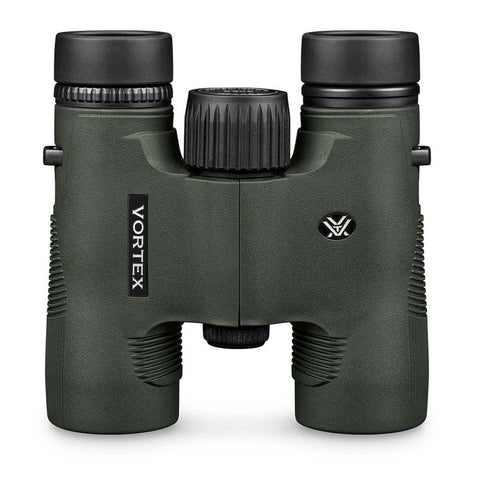Binoculars are an excellent tool, whether you’re birdwatching or out on the hunt. Two of the most popular are the Athlon Midas and the Vortex Diamondback. In this article, we’ll discuss the two products to determine the best option for your outdoor experience.

Technical Specifications
Technical specifications are one of the most critical parts of a pair of binoculars. Without an understanding of the inner workings of the system, it’s tricky to tell which item is better from the outside. It’s helpful to understand the details that make up the system.
For instance, every pair of binoculars has a prism type inside the system. The Athlon Midas has a roof prism, and so does the Vortex Diamondback. This variety splits the light into two pathways before bringing them back together into one valuable image for your benefit.
There is no winner in this category, as the Midas and Diamondback have the same prism systems. However, there are other technical areas where the binoculars differ, each providing different abilities for the users.
Let’s dive into more technical specifications with the Athlon Midas and Vortex Diamondback. Performance matters in a pair. Next, we’ll dive into magnification, angle of view, exit pupil diameter, and more vital information you should have under your belt before buying your next pair.
Performance
Performance determines how well a pair of binoculars will perform when put to work. The better the performance, the easier it will be to spot targets far off in the distance. The Midas and the Diamondback each have different offerings to users.
There are many ways in which the Midas and Diamondback are similar. They both have a magnification of 8x, an objective lens diameter of 42 mm, and a center focus type. They also have an unspecified diopter adjustment - but that’s where the similarities end in these products.
The actual angle of view for the Midas is 8.1 degrees, while the Diamondback offers an actual angle of view of 7.5 degrees. The field of view for the Midas is 426’ @ 1000 yards, while the Diamondback provides 393’ @ 1000 yards, about a thirty-foot difference between the two.
There are other separations, too. The Midas has a minimum focus distance of 6.5’, while the competing Diamondback sits at 5’. The Midas has an exit pupil diameter of 5.25 mm, and the Diamondback has one of 5.3 mm, about a 1.5-foot difference.
Finally, the eye relief for the Midas is 17.2 mm, while the Diamondback is 17 mm. The interpupillary adjustment for the Midas is 57 to 74 mm, while the Diamondback offers 55 to 75 mm.
It’s a tight competition between these pairs. However, we think the Athlon Midas is the winner, thanks to the actual angle of view and the field of view. Although you don’t get as much adjustment and minimum focus distance, the vision is worth it.
Performance is critical in a pair of binoculars. Next, let’s talk about the unique features each option provides the user to help them see well, even in the worst weather conditions.
Features
Next up are the features of each pair of binoculars. Although these aren’t necessary, they add to the experience and your overall ability to make the most out of your pair while on the move.
Both the Athlon Midas and Vortex Diamondback boast fog proof capabilities thanks to argon. The gas is pumped through the system, allowing them to withstand humid conditions without filling up the glass with a haze. It’s excellent for those who live in humid conditions and need assistance to keep their sight clear amidst the unfortunate weather.
The Midas and Diamondback are also waterproof, meaning you can drop them in water up to a certain depth and they will work fine. They will also survive in the rain, allowing you more versatility when and where you use the product.
There is no winner here. The Athlon Midas and Vortex Diamondback are each fog proof and waterproof, ensuring they will stay in one piece in even the craziest weather conditions. They are built to last, even in pouring rain and humidity.
We’ve touched on various details surrounding the Midas and Diamondback, from the prism inside to the general features of each product for users. Now, let’s make one final analysis by considering the general specifications of each pair.

General
General features typically include the dimensions and weight of a product. If a pair of binoculars is too big or heavy, it will be impractical for the user to carry around. A quality product is lightweight and small yet provides an excellent view for the user.
First, the dimensions. The Athlon Midas is 5.7 x 5.2 inches, which translates to 14.5 x 13.2 centimeters. The competing Vortex Diamondback is 5.8 x 5.1 inches, which translates to 14.7 x 12.9 centimeters.
Next, the weight. The Athlon Midas is 25 ounces, which translates to 708.8 grams. The competing Vortex Diamondback is 21.8 ounces, or 618 grams.
The winner in this category is the Vortex Diamondback. Although it’s slightly larger than the Athlon Midas, it weighs less. It offers more room for you to get the right view without being too much to hold up while on the move.
We’ve gone over the technical specifications and the general features of the Athlon Midas and Vortex Diamondback. Now, it’s time to consider which product is the better of the two. Is the Athlon Midas the winner or is the Vortex Diamondback on top?
Conclusion
Although there are quality features inside the Athlon Midas and Vortex Diamondback, the Athlon Midas is the better choice. It matches the Diamondback in most areas, then exceeds it in visibility. If you have the funds, go with the Midas for your next pair of binoculars.
Whether you pick the Athlon Midas or the Vortex Diamondback, you can be sure you are investing in a quality product. Athlon and Vortex are top-notch brands, and each is made with careful details and mechanics. Both are excellent.
